Computed Tomography Attenuation of Three-Dimensional (3D) Printing Materials—Depository to Aid in Constructing 3D-Printed Phantoms
Abstract
:1. Introduction
2. Materials and Methods
3. Results
4. Discussion
5. Conclusions
Author Contributions
Funding
Data Availability Statement
Conflicts of Interest
References
- Attaran, M. The rise of 3-D printing: The advantages of additive manufacturing over traditional manufacturing. Bus. Horiz. 2017, 60, 677–688. [Google Scholar] [CrossRef]
- Dorweiler, B.; Baqué, P.E.; Chaban, R.; Ghazy, A.; Salem, O. Quality Control in 3D Printing: Accuracy Analysis of 3D-Printed Models of Patient-Specific Anatomy. Materials 2021, 14, 1021. [Google Scholar] [CrossRef]
- Ogden, K.M.; Aslan, C.; Ordway, N.; Diallo, D.; Tillapaugh-Fay, G.; Soman, P. Factors Affecting Dimensional Accuracy of 3-D Printed Anatomical Structures Derived from CT Data. J. Digit. Imaging 2015, 28, 654–663. [Google Scholar] [CrossRef] [PubMed]
- Shearn, A.I.U.; Yeong, M.; Richard, M.; Ordoñez, M.V.; Pinchbeck, H.; Milano, E.G.; Hayes, A.; Caputo, M.; Biglino, G. Use of 3D Models in the Surgical Decision-Making Process in a Case of Double-Outlet Right Ventricle With Multiple Ventricular Septal Defects. Front. Pediatr. 2019, 7, 330. [Google Scholar] [CrossRef]
- Ganapathy, A.; Chen, D.; Elumalai, A.; Albers, B.; Tappa, K.; Jammalamadaka, U.; Hoegger, M.J.; Ballard, D.H. Guide for starting or optimizing a 3D printing clinical service. Methods 2022, 206, 41–52. [Google Scholar] [CrossRef]
- Borrello, J.; Nasser, P.; Iatridis, J.; Costa, K.D. 3D Printing a Mechanically-Tunable Acrylate Resin on a Commercial DLP-SLA Printer. Addit. Manuf. 2018, 23, 374–380. [Google Scholar] [CrossRef]
- Xu, X.; Goyanes, A.; Trenfield, S.J.; Diaz-Gomez, L.; Alvarez-Lorenzo, C.; Gaisford, S.; Basit, A.W. Stereolithography (SLA) 3D printing of a bladder device for intravesical drug delivery. Mater. Sci. Eng. C Mater. Biol. Appl. 2021, 120, 111773. [Google Scholar] [CrossRef] [PubMed]
- Quan, H.; Zhang, T.; Xu, H.; Luo, S.; Nie, J.; Zhu, X. Photo-curing 3D printing technique and its challenges. Bioact. Mater. 2020, 5, 110–115. [Google Scholar] [CrossRef]
- O’Reilly, M.; Hoff, M.; Friedman, S.D.; Jones, J.F.X.; Cross, N.M. Simulating Tissues with 3D-Printed and Castable Materials. J. Digit. Imaging 2020, 33, 1280–1291. [Google Scholar] [CrossRef] [PubMed]
- Mix, A.; Giacomin, A. Standardized polymer durometry. J. Test. Eval. 2011, 39, 696–705. [Google Scholar]
- Ma, D.; Gao, R.; Li, M.; Qiu, J. Mechanical and medical imaging properties of 3D-printed materials as tissue equivalent materials. J. Appl. Clin. Med. Phys. 2022, 23, e13495. [Google Scholar] [CrossRef] [PubMed]
- Shin, J.; Sandhu, R.S.; Shih, G. Imaging Properties of 3D Printed Materials: Multi-Energy CT of Filament Polymers. J. Digit. Imaging 2017, 30, 572–575. [Google Scholar] [CrossRef] [PubMed]
- Dancewicz, O.L.; Sylvander, S.R.; Markwell, T.S.; Crowe, S.B.; Trapp, J.V. Radiological properties of 3D printed materials in kilovoltage and megavoltage photon beams. Phys. Med. 2017, 38, 111–118. [Google Scholar] [CrossRef] [PubMed]
- Silvestro, E.; Betts, K.N.; Francavilla, M.L.; Andronikou, S.; Sze, R.W. Imaging Properties of Additive Manufactured (3D Printed) Materials for Potential Use for Phantom Models. J. Digit. Imaging 2020, 33, 456–464. [Google Scholar] [CrossRef] [PubMed]
- Mooney, J.J.; Sarwani, N.; Coleman, M.L.; Fotos, J.S. Evaluation of Three-Dimensional Printed Materials for Simulation by Computed Tomography and Ultrasound Imaging. Simul. Healthc. 2017, 12, 182–188. [Google Scholar] [CrossRef] [PubMed]
- Kunert, P.; Trinkl, S.; Giussani, A.; Reichert, D.; Brix, G. Tissue equivalence of 3D printing materials with respect to attenuation and absorption of X-rays used for diagnostic and interventional imaging. Med. Phys. 2022, 49, 7766–7778. [Google Scholar] [CrossRef]
- Ma, X.; Figl, M.; Unger, E.; Buschmann, M.; Homolka, P. X-ray attenuation of bone, soft and adipose tissue in CT from 70 to 140 kV and comparison with 3D printable additive manufacturing materials. Sci. Rep. 2022, 12, 14580. [Google Scholar] [CrossRef]
- Jusufbegović, M.; Pandžić, A.; Šehić, A.; Jašić, R.; Julardžija, F.; Vegar-Zubović, S.; Beganović, A. Computed tomography tissue equivalence of 3D printing materials. Radiography 2022, 28, 788–792. [Google Scholar] [CrossRef]
- Bibb, R.; Thompson, D.; Winder, J. Computed tomography characterisation of additive manufacturing materials. Med. Eng. Phys. 2011, 33, 590–596. [Google Scholar] [CrossRef] [PubMed]
- Ma, X.; Buschmann, M.; Unger, E.; Homolka, P. Classification of X-Ray Attenuation Properties of Additive Manufacturing and 3D Printing Materials Using Computed Tomography From 70 to 140 kVp. Front. Bioeng. Biotechnol. 2021, 9, 763960. [Google Scholar] [CrossRef] [PubMed]
- Holleran, S.; Ramakrishnan, R. Cufunctions, a Package to Facilitate Statistical Analyses in R. Available online: http://biomath.net/cufunctions.html (accessed on 14 August 2023).
- DenOtter, T.D.; Schubert, J. Hounsfield Unit; StatPearls Publishing: Treasure Island, FL, USA, 2019. [Google Scholar]
- Marques, M.L.; da Silva, N.P.; van der Heijde, D.; Reijnierse, M.; Baraliakos, X.; Braun, J.; van Gaalen, F.; Ramiro, S. Hounsfield Units measured in low dose CT reliably assess vertebral trabecular bone density changes over two years in axial spondyloarthritis. Semin. Arthritis Rheum. 2023, 58, 152144. [Google Scholar] [CrossRef] [PubMed]
- Nute, J.L.; Le Roux, L.; Chandler, A.G.; Baladandayuthapani, V.; Schellingerhout, D.; Cody, D.D. Differentiation of low-attenuation intracranial hemorrhage and calcification using dual-energy computed tomography in a phantom system. Investig. Radiol. 2015, 50, 9–16. [Google Scholar] [CrossRef]
- Toga, A.W.; Mazziotta, J.C. Brain Mapping: The Methods; Academic Press: Cambridge, MA, USA, 2002; Volume 1. [Google Scholar]
- Batawil, N.; Sabiq, S. Hounsfield unit for the diagnosis of bone mineral density disease: A proof of concept study. Radiography 2016, 22, e93–e98. [Google Scholar] [CrossRef]
- Yaprak, G.; Gemici, C.; Seseogullari, O.O.; Karabag, I.S.; Cini, N. CT Derived Hounsfield Unit: An Easy Way to Determine Osteoporosis and Radiation Related Fracture Risk in Irradiated Patients. Front. Oncol. 2020, 10, 742. [Google Scholar] [CrossRef] [PubMed]
- Attix, F.H. Introduction to Radiological Physics and Radiation Dosimetry; John Wiley & Sons: Hoboken, NJ, USA, 2008. [Google Scholar]
- Giordano Ii, R. Ceramics overview. Br. Dent. J. 2022, 232, 658–663. [Google Scholar] [CrossRef] [PubMed]
- Solomon, J.; Ba, A.; Bochud, F.; Samei, E. Comparison of low-contrast detectability between two CT reconstruction algorithms using voxel-based 3D printed textured phantoms. Med. Phys. 2016, 43, 6497. [Google Scholar] [CrossRef] [PubMed]
- Anwari, V.; Lai, A.; Ursani, A.; Rego, K.; Karasfi, B.; Sajja, S.; Paul, N. 3D printed CT-based abdominal structure mannequin for enabling research. 3D Print Med. 2020, 6, 3. [Google Scholar] [CrossRef]
- Gear, J.I.; Long, C.; Rushforth, D.; Chittenden, S.J.; Cummings, C.; Flux, G.D. Development of patient-specific molecular imaging phantoms using a 3D printer. Med. Phys. 2014, 41, 082502. [Google Scholar] [CrossRef]
- Mashari, A.; Montealegre-Gallegos, M.; Jeganathan, J.; Yeh, L.; Qua Hiansen, J.; Meineri, M.; Mahmood, F.; Matyal, R. Low-cost three-dimensional printed phantom for neuraxial anesthesia training: Development and comparison to a commercial model. PLoS ONE 2018, 13, e0191664. [Google Scholar] [CrossRef]


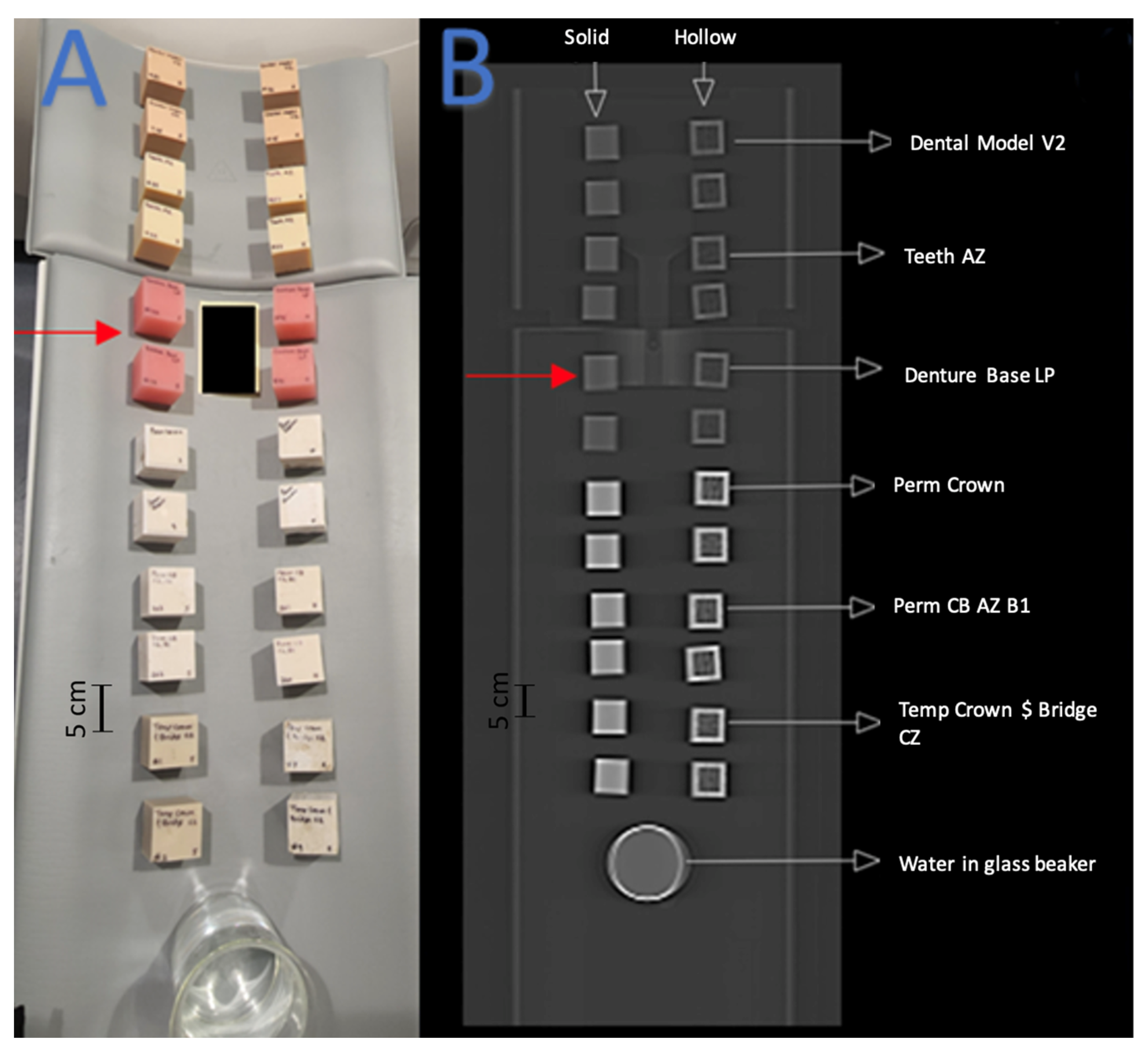
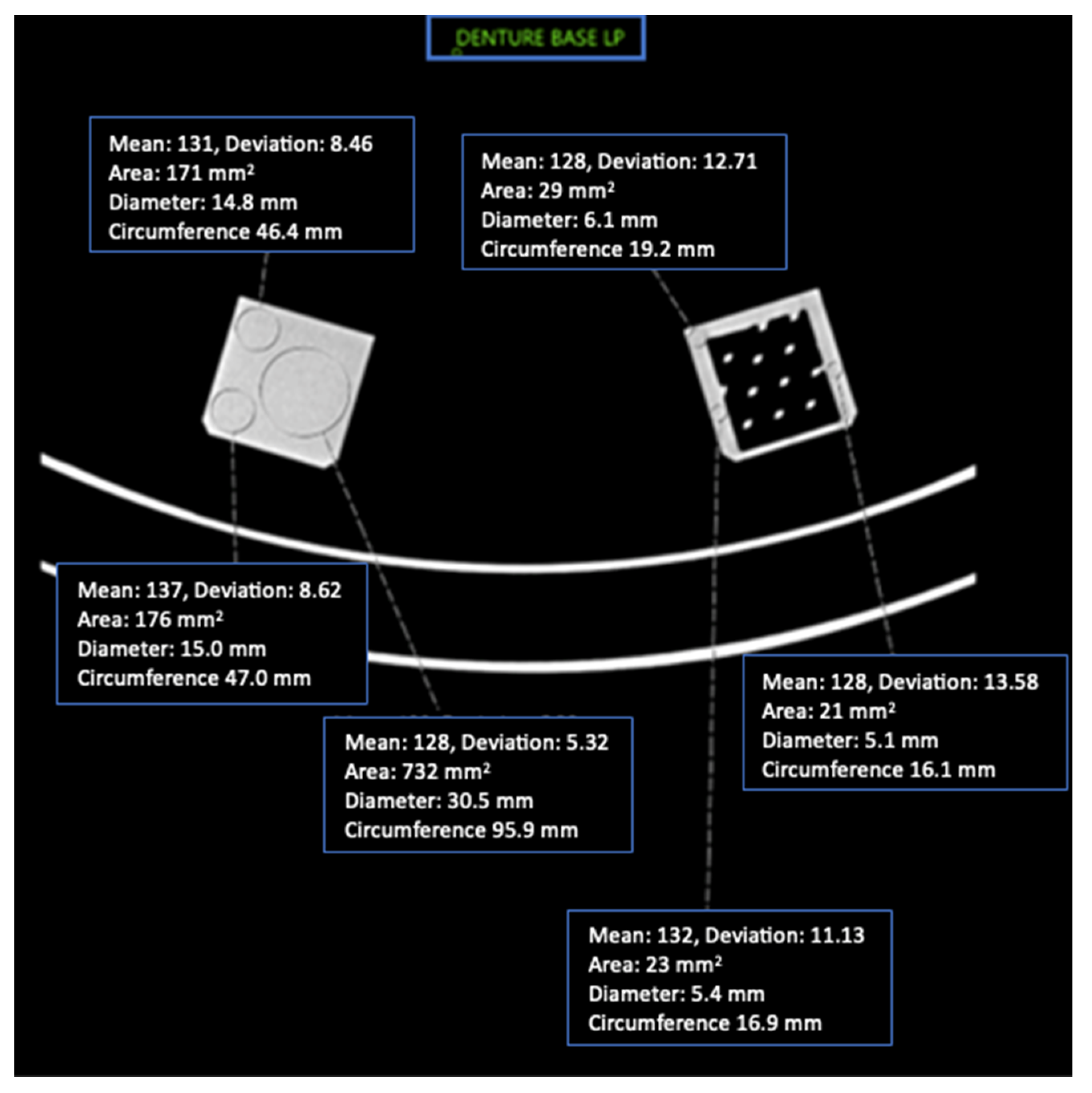
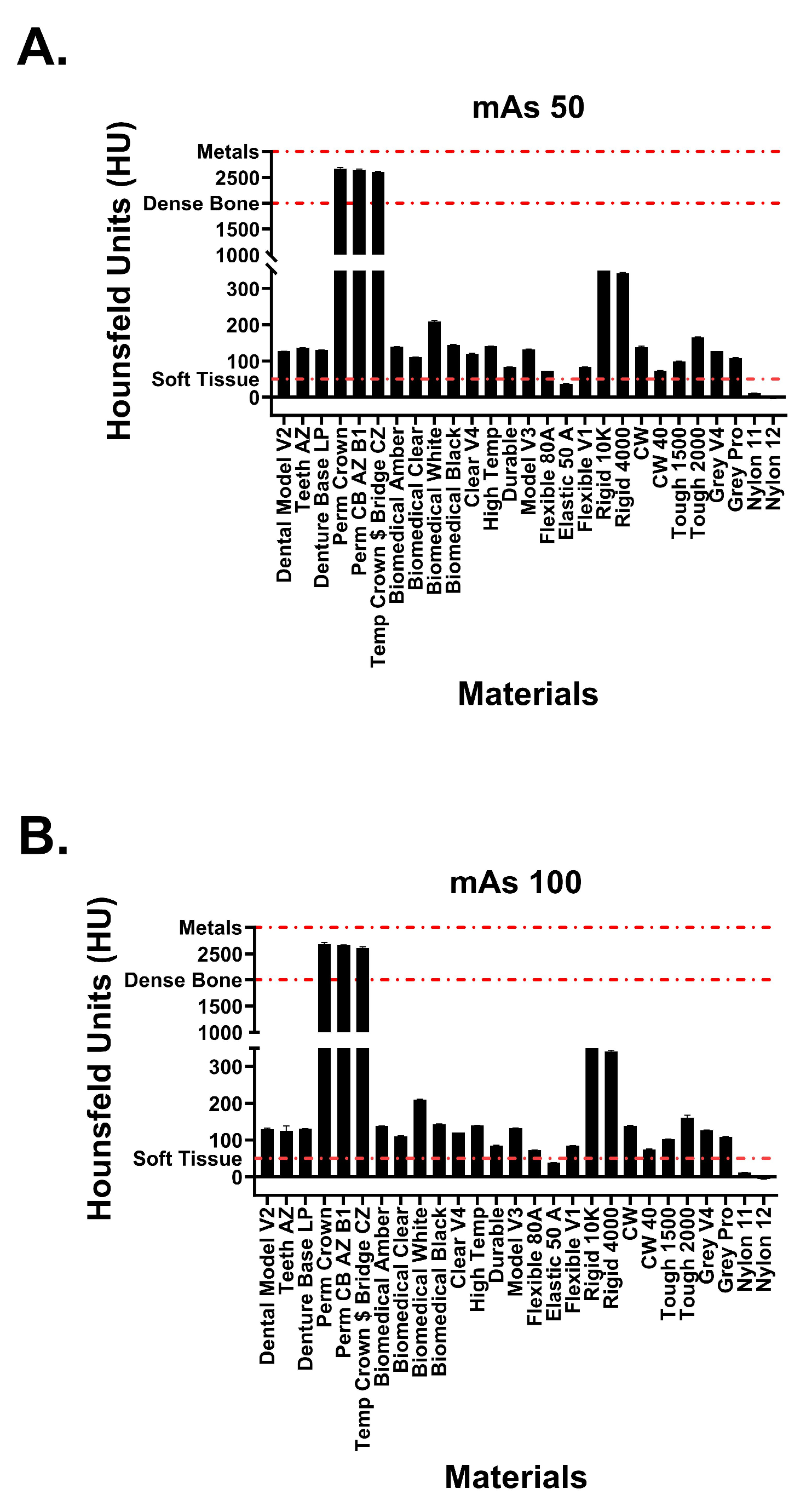
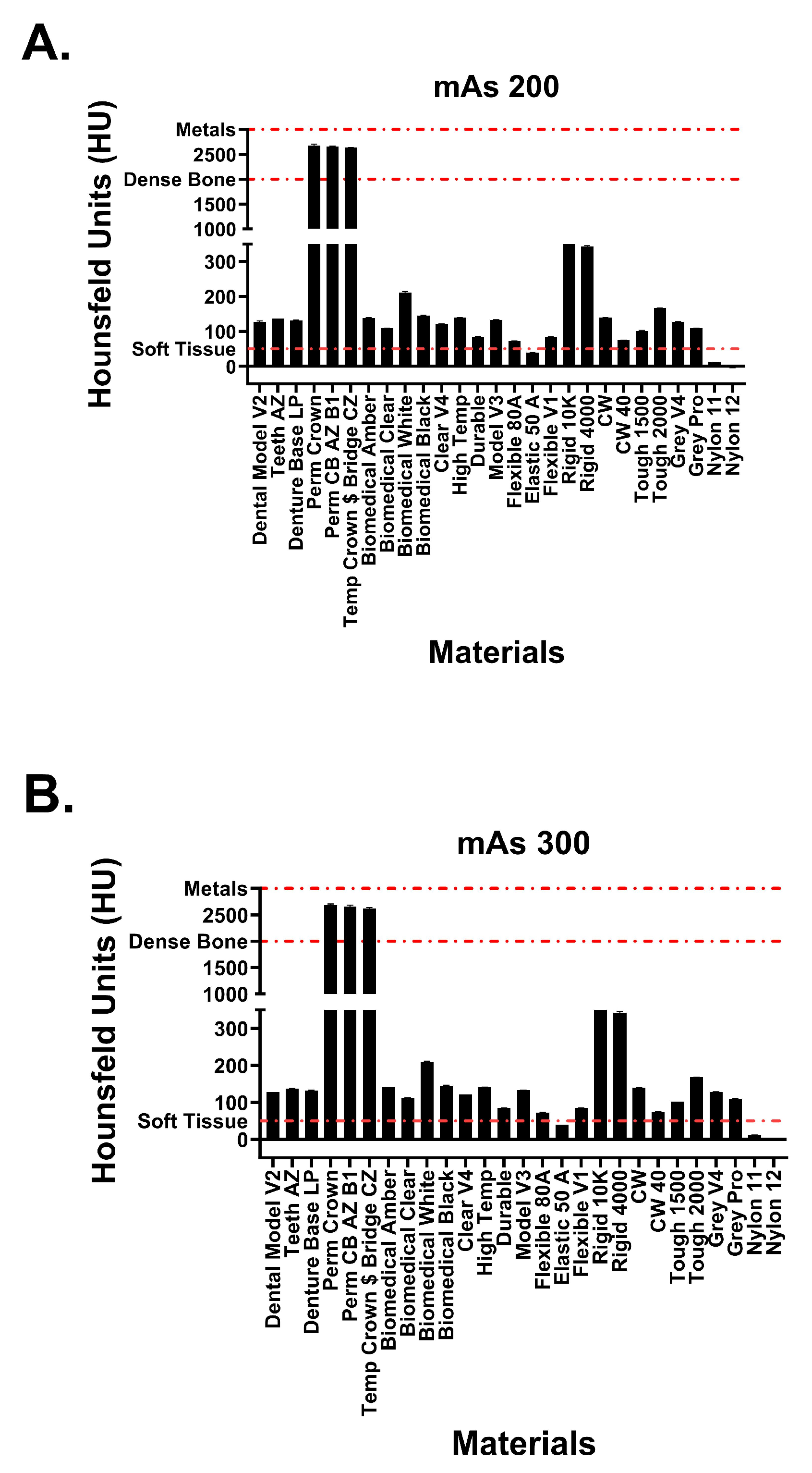
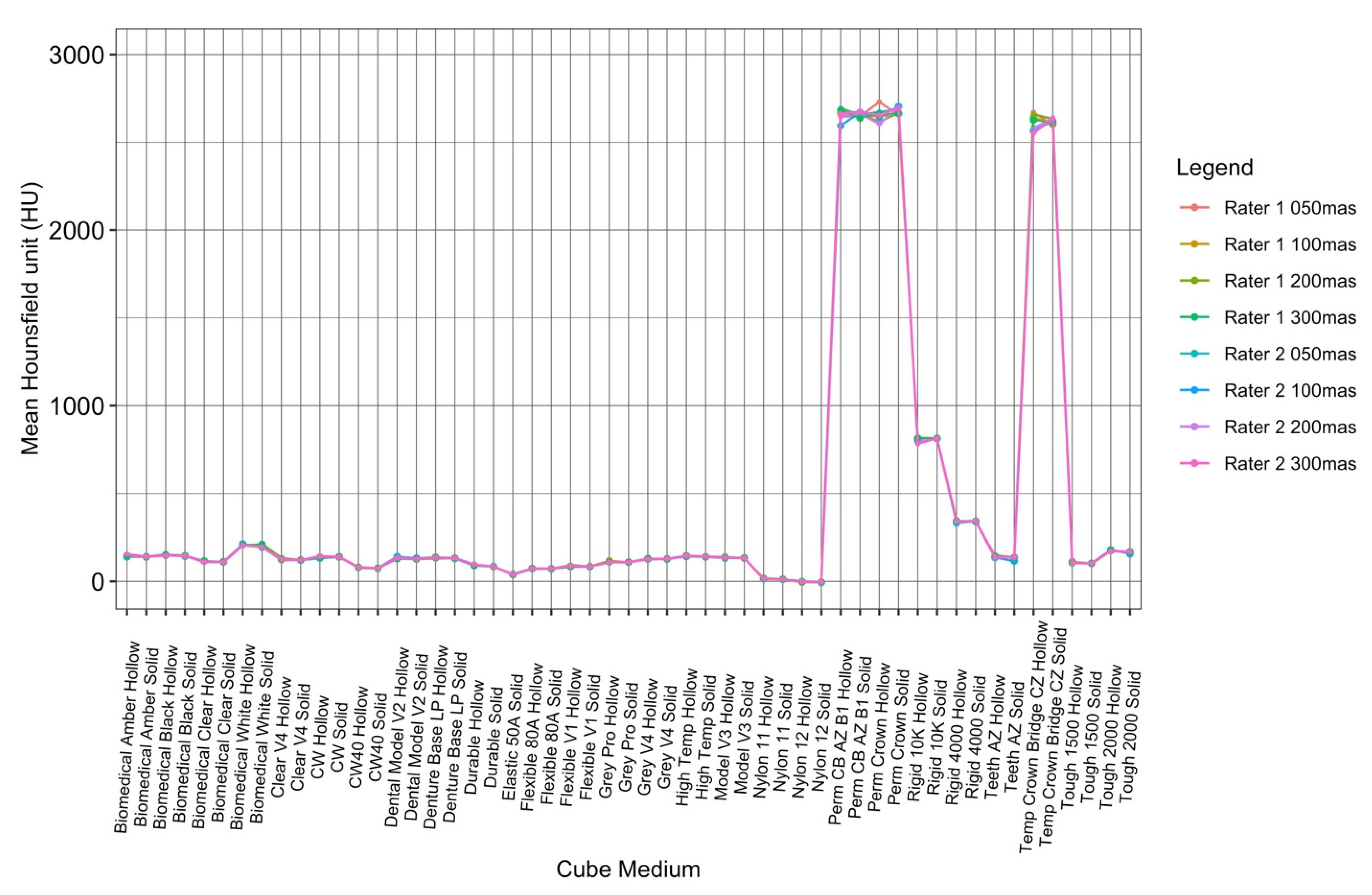
| Materials | mAs = 50 | mAs = 100 | mAs = 200 | mAs = 300 | Average |
|---|---|---|---|---|---|
| Dental Model V2 | 127.17 | 129.415 | 127 | 128.085 | 127.9175 |
| Teeth AZ | 137.08 | 125.25 | 137.25 | 137.085 | 134.1663 |
| Denture Base LP | 131.085 | 130.585 | 132 | 132.17 | 131.46 |
| Perm Crown | 2671.33 | 2685.335 | 2675.25 | 2680.33 | 2678.061 |
| Perm CB AZ B1 | 2651.25 | 2669.165 | 2655.667 | 2656.915 | 2658.249 |
| Temp Crown $ Bridge CZ | 2603.499 | 2612.249 | 2636.334 | 2621.669 | 2618.437 |
| Biomedical Amber | 139.665 | 138.915 | 139.335 | 140.8334 | 139.6871 |
| Biomedical Clear | 110.17 | 110.42 | 109.415 | 110.915 | 110.23 |
| Biomedical White | 209.915 | 209.765 | 211.085 | 209.585 | 210.0875 |
| Biomedical Black | 145.585 | 143.585 | 145.335 | 145.58 | 145.0213 |
| Clear V4 | 120.335 | 120.67 | 121.335 | 121.67 | 121.0025 |
| High Temp | 140.5 | 139.75 | 139.5 | 140.58 | 140.0825 |
| Durable | 84.63 | 84.61 | 85.23 | 84.735 | 84.80125 |
| Model V3 | 132.5 | 132.92 | 133 | 133.085 | 132.8763 |
| Flexible 80A | 72.14 | 72.035 | 71.72 | 72.45 | 72.08625 |
| Elastic 50A | 37.95 | 38.415 | 39.945 | 39.255 | 38.89125 |
| Flexible V1 | 84.055 | 83.855 | 84.785 | 84.14 | 84.20875 |
| Rigid 10K | 813.17 | 812.08 | 813.585 | 813.835 | 813.1675 |
| Rigid 4000 | 342.42 | 341.25 | 343.08 | 342.5 | 342.3125 |
| CW | 138.415 | 139.08 | 139.5 | 139.915 | 139.2275 |
| CW 40 | 73.905 | 74.2 | 74.64 | 74.47 | 74.30375 |
| Tough 1500 | 99.37 | 102.145 | 101.525 | 102.49 | 101.3825 |
| Tough 2000 | 166.335 | 161.415 | 166.915 | 167.92 | 165.6463 |
| Grey V4 | 127.585 | 127.08 | 127.585 | 128.25 | 127.625 |
| Grey Pro | 108.5 | 109 | 109 | 109.75 | 109.0625 |
| Nylon 11 | 11.72 | 11.755 | 11.625 | 11.66 | 11.69 |
| Nylon 12 | −3.575 | −6.075 | −2.92 | −4.16 | −4.1825 |
| Tube Current (mAs) | ICC Value |
|---|---|
| 50 mAs | 0.9998941 |
| 100 mAs | 0.9999364 |
| 200 mAs | 0.9998341 |
| 300 mAs | 0.9999283 |
| Resins | Mean HU | Tissue/Pathology Mimic | Reference |
|---|---|---|---|
| Perm Crown, Perm CB AZ B1, Temp Crown $ Bridge CZ | 2651.582333 | Dense bony tissue (cortical bone) and metal | [22] |
| Rigid 10k | 813.1675 | Upper limits of trabecular bone attenuation | [23,24,25] |
| Rigid 4000 | 342.3125 | Lower limits of trabecular bone attenuation | [23,24,25] |
| Dental Model V2, Teeth AZ, Denture Base LP, biomedical amber, biomedical clear, biomedical white, biomedical black, Clear V4, High temp, model V3, CW, Tough 1500 and 2000, Grey V4 and Pro | 135.6983 | Lumbar vertebrae with osteopenia or osteoporosis | [26,27] |
| Nylon 12 | −4.1825 | Water and other simple fluids | [9,22] |
| Nylon 11 | 11.69 | CSF | [22] |
| Flexible 80A | 72.08625 | Muscle/soft tissue | [9,22] |
| Flexible V1 | 84.20875 | Intracranial hemorrhage | [9,22] |
| Elastic 50A | 38.89125 | Blood | [9,22] |
Disclaimer/Publisher’s Note: The statements, opinions and data contained in all publications are solely those of the individual author(s) and contributor(s) and not of MDPI and/or the editor(s). MDPI and/or the editor(s) disclaim responsibility for any injury to people or property resulting from any ideas, methods, instructions or products referred to in the content. |
© 2023 by the authors. Licensee MDPI, Basel, Switzerland. This article is an open access article distributed under the terms and conditions of the Creative Commons Attribution (CC BY) license (https://creativecommons.org/licenses/by/4.0/).
Share and Cite
Kalidindi, Y.; Ganapathy, A.K.; Nayak, Y.; Elumalai, A.; Chen, D.Z.; Bishop, G.; Sanchez, A.; Albers, B.; Shetty, A.S.; Ballard, D.H. Computed Tomography Attenuation of Three-Dimensional (3D) Printing Materials—Depository to Aid in Constructing 3D-Printed Phantoms. Micromachines 2023, 14, 1928. https://doi.org/10.3390/mi14101928
Kalidindi Y, Ganapathy AK, Nayak Y, Elumalai A, Chen DZ, Bishop G, Sanchez A, Albers B, Shetty AS, Ballard DH. Computed Tomography Attenuation of Three-Dimensional (3D) Printing Materials—Depository to Aid in Constructing 3D-Printed Phantoms. Micromachines. 2023; 14(10):1928. https://doi.org/10.3390/mi14101928
Chicago/Turabian StyleKalidindi, Yuktesh, Aravinda Krishna Ganapathy, Yash Nayak, Anusha Elumalai, David Z. Chen, Grace Bishop, Adrian Sanchez, Brian Albers, Anup S. Shetty, and David H. Ballard. 2023. "Computed Tomography Attenuation of Three-Dimensional (3D) Printing Materials—Depository to Aid in Constructing 3D-Printed Phantoms" Micromachines 14, no. 10: 1928. https://doi.org/10.3390/mi14101928





